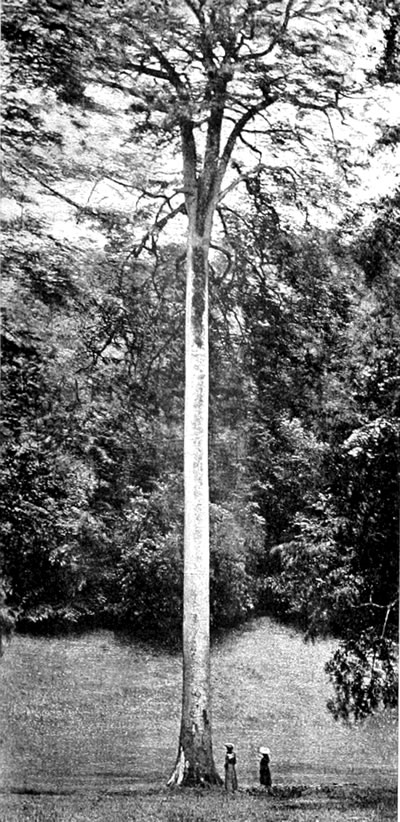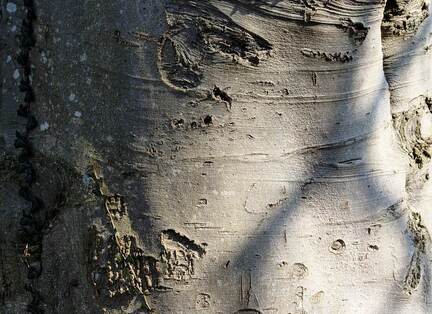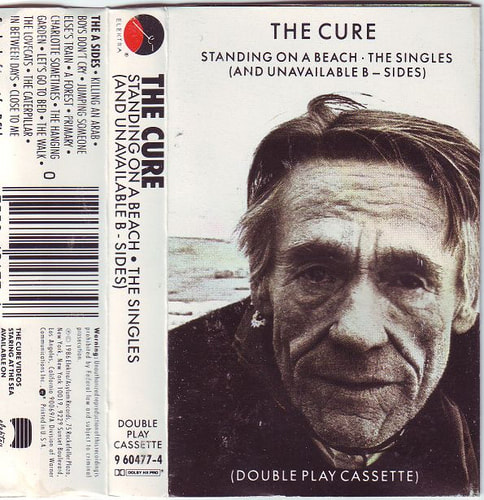 The Queen Beech at Ashridge Park Hertfordshire The Queen Beech at Ashridge Park Hertfordshire You probably already know this, but for the few who didn't grow up beech-side, here it goes. We lived inland from the water's edge, and this being so, summers were hot. Our windows could never open wide enough to gulp cool breezes. Fans sat on every sill thrumming on high, imbalanced metal blades ticking behind broken plastic slats. Myself, my siblings & stray cats lay still on our backs, with a cool damp wash-cloth on our forehead, chest, or neck to sooth steamy squalor. Humid red leaves shook outside, flicking behind amber street-lights glowing through our chattering box-fans. Wee children restlessly succumbed to sweaty sleep. During the daylight of Mid-July, the heat was nearly as unbearable as several sleepless children. By Eleven, My mother would cave under pressure to the mid-day sun, and we'd load spent ice-cream pails, buckets, and other crap into a cracked plastic laundry basket, PB&J packed, all takers would herd into a rusty suburban, en-route to the Beach. Visiting the Beech By late afternoon, scalding toes upon hot sand, we'd retreat from the beach as bright as blushing grapefruit. Starving, we'd transport an island of sand, deep set within our hair, ears, and socks back home, (if we could find our hideous socks at all). Arriving home, to the hose ritual, we'd stand beneath the shade of a massive Beech tree, before being allowed inside. The rinse cycle, like a prison delousing, liberated most of our sand... while it seemed to activate our sunburn. The Trunk of the beech tree beside the house swelled from our careless hose-play, and through a wet spring, it's roots swelled to heave the pavement squares upward, like an earthquake, so the steps became a hazard. Loosely rinsed beneath the purple canopy of the massive 'Silver Beach', we'd towel off; Only then were we permitted to enter the house buying my mother scant time to prepare dinner. By high school, it became clear that without these shady giants surrounding our home, we'd have all died like flies, or killed each-other. Our shade beneath one massive elephant-silver Beech tree was a critical sanctuary. Like a Hospital ship in wartime, other broke kids came to sit under it's cooler environs. As a child, three kids could not lock hands reaching around it's trunk. As it swelled from snow & spring rain, new eyes creased it's smooth grey bark, symbolizing my brother's birthday in a wink. In rainy years the mighty Beech roots wandered through and drank from every single drain and storm-sewer on our block. You could record the rainy years by the frequency of Rotor-rooter visits to our home and to our neighbors. Wrinkles formed and split the rhinoceros hide of it's huge trunk slowly. We thought it's bark was deliberately slippery, to remain the only of eight trees around the house which we could never climb. A massive grey and purple Beech Tree, protected our family from devolving into overheated chaos throughout summer. While growing up we knew it as "The Beach Tree". A singular phenomena, A super-hero which we never saw protecting another family in our town. Our "Beach" was our sanctuary. So It happens that any tree is not so simple to understand. Carrying stories, histories, and secrets -- Trees are humanized in fiction, film, and perhaps in reality. They shed, and mate, multiply, fertilize, drop food for their children, and protect their young and neighbors much like the best of us. Arborists, speak of trees for what they can provide to humans, while "Tree Huggers" tend to obsess, and that reverence is well deserved, but of course it is inadequate. Each and every year of everyone's life is in fact etched somewhere deep within their tree. L.G.Beech.T.Q. As it turns out Beeches are transgender (so to speak) monoecious, bearing both male and female flowers on the same plant. The small buds are unisexual, the female flowers are born in pairs, While male flowers are wind-pollinating catkins. Shortly after new leaves appear in early spring, The beech bears tiny fruit, known as 'beechnuts'. (This was also a Coffee brand when I was growing up, next to Folgers, and Maxwell House... All of them sucked) The 'beach' keeps it's secret burrs until autumn, when it's nuts fall to earth. These beech nuts are edible -- awkward triangle nuts, are as bitter as hops, although sometimes mild and nutty, like pine nuts. They have a high enough oily fat that they can be pressed -- But I never recall our Tree dropping any nuts. Our tree was too busy protecting my family from devolving into chaos, and death. So what is to be said of a Beech Tree. Some arborists, (not Tree-huggers) say the Beech is good kindling. Some say it's Crappy for building stuff. I understand that there are many tree brands which build better, wear better, and seem to make the Man. But consider this: This Humble Beech tree...  Buckingham Palace the unnatural outgrowth of a royal deciduous tree. Buckingham Palace the unnatural outgrowth of a royal deciduous tree. Standing on a Beech Aging we may see a humble Beech tree, at roughly 132 feet tall and nearly 12 foot three inches in girth, its bole straight and branchless for 80 feet straight up. To comprehend a tall smooth tree, we need perspective, just like a castle needs an approach to give it context too the landscape. In a forest, most trees blend away any special reverence. Taken alone, a tall tree gives us the context to comprehend what a fascinating being it is. You may be 6 foot tall if you're well fed. Now divide 5 into 132, if you imagine standing on another's shoulders... (we subtract your head) Now stack 26 more people. Giant trees are mostly anomalies today, in cities, as they struggle for space, and food... but not unusual through history, mostly owing to abundant food resources, the endless deep earth, friendly neighbors, and the general advocacy of those who plant them. Trees like these grow, in lock-step with people, except that the trees get to stand while we disappear. Not surprisingly we will feed a tree like this, while they silently watch over our passing. A beautiful Beech tree like other deciduous kin seem to struggle with our clumsy tactics at living. Beeches and the Jacobite consolidation In Scotland, as the Jacobite revolution brought a peace under Prince Charles Edward, and later a United Kingdom consolidated under King George V; The union of English and Scottish Legislatures yielded a new peace and security within the Northern Kingdom unseen since the death of Alexander III in 1286. But for those who opposed the Scots' merger, Beech trees planted along the fast flow of the Arkaig river of Achnacarry hold a more sorrowful significance. It was the Land of Highland chiefs like the Lord (Laird) Donald Cameron of Lochiel, who was already advanced in age, when Prince Charlie landed at Borrowdale in July. The Prince who changed Scotland forever summoned the highland chiefs to Charlie's retreat. Laird Cameron's brother John begged him not to attend, saying, "I know you far better than you know yourself, and if the Prince once sets eyes upon you, he will make you do as he pleases". But... As it happened Laird Cameron's younger brother John was right predicting precisely how things would shake out. Initially resisting risks to his clan, Later Laird Donald Cameron leaving comfortable seclusion yielded to the Persuasive Prince Edward. He returned home and marshaled fourteen hundred highlanders to take part in Charlie's absurd campaign, until Laird Cameron was carried off the battle field of Culloden gravely wounded in 1746. While Lord Cameron was away in battle, his order of young beech trees arrived at his home at Achnacarry, awaiting direction. The Beautiful beeches were heeled in a tight row beside the river where they drank, and gossiped, but the Chieftain never returned to Lochaber to plant them. Rather he lingered a few years in exile, his estates forfeited to the English throne, and Lord Cameron died in 1748, and with him Scottish Independence. The Beech trees were never "planted" rather they remained closely moored in the trench beside the Arkaig river, drinking and growing. These royal Beeches were raised in a trench so closely set that a person could not squeeze between their silver trunks. It's said that the "Winds of winter wail a Coronach among the bare boughs" "No more pathetic memorial could be designed for a lost cause, and for him whom men spoke of as the 'Gentle Lochiel'". Beeches and Budweiser I'm an optimist in-spite of apparent reasons to the contrary. Let' s assume that it's OK to just expire while giants watch over us. This will in the very least allow us to cling to a dream -- To fade under the shade of a beautiful tree. Beech trees like the one here are not, nor were they ever regarded fondly for making things. Beech burns hot, makes a beautiful fire..., but it does not stay straight, supportive, nor resist rot or pests, when cut; to that extent it is not necessarily cherished as a building material. Beech trees burn hotter than nearly anything else, and Beech has a lovely flavor. So desirable is it's fragrant vein, the Beech is renown for creating the Budweiser Brand in America. Beech wood was lain upon the tempering vats of Budweiser for Twenty-one days as it's "secret recipe". Many other brands have touted "Beechwood Aging" as a way to temper the perfect pale lager; but you need to cut a shit-ton of beautiful trees when your public gets thirsty.  So what else lies in the sordid history of such a noble guardian, as it considers being cut-down for waste to make your average beer? Here is another blue-blooded reason that Budweiser may be deserving of gorgeous Clydesdales, and I assure you it is not the taste, nor the quality contained in your can of Budweiser. Beeches Building Landmarks There are several other more regal reasons to consider the humble beech tree as your best tree pal, namely it's blue-blood lineage. Take for example the word itself and the seemingly week utility of the wimpy Beech tree. Beech is Perishable, Hard, and brittle under most uses, and as such it is often burned, because that is what is best at. The Beech however was selected to support the footings of Winchester in the wet peat bogs which undermine support of such a massive landmark. It is Beech logs which were lain well below the building of Cathedrals under London, and rural palaces which may not still stand, were not for the magical capability of Beech to stay strong sweating under damp duress. It may not seem real that the penultimate shade tree remain so durable when wet, but for upwards of seven-hundred years these beech trees set in the ground, faithfully supported their function beneath the Lady Chapel of Westminster, erected by Bishop Godfrey de Lucy only a few years before he died in 1204, Today the beech timber are still perfectly hard and sound. This is the humble beech which most forestry experts revere as great for S'mores. The Humble beech may support more than your perfect campfire. The tree which prevented the decay of my Family whilst growing up, was just shade, for sure, but it's epic lineage was evident right upon it's surface... It's texture, and space-alien gray trunk looks like nothing else. The Beech is more than an eight-hundred plus year old foundation of the worlds most iconic architecture... The Beech Tree may also be progenitor for a royal name. Beeches Royals & their Books Miraculous by Nature and for fancier reasons the humble beech is better than you may have thought: So bring your skepticism to this story. "Trees, A Woodland Journal" By James Macklehose c. 1915 "In Northern England through the middle ages the Beech was coveted as drain-tile soles in wet-land Britain. The timber was put to far-higher purpose in Buckinghamshire, where extensive beech forests around High Wycombe and Newport Pagnell provided timber for creative wood-craft in England. These trees were regularly grown and felled responsibly to supply the chairmaking industry. Useful 'clean timber' commanded, higher prices as it was consumed. Historians recite the very name Buckingham to have been derived from the Anglo-Saxon boc, a beech; but it appears in the "Winchester Chronicle" as Buccingaham, which indicates its origin in the family named Buccing, descended from an ancestor or chief called Bucca, the Buck. Howbeit, we are incessantly, though unconsciously, using the Anglo-Saxon boc, for it was smooth tablets or panels of beech that formed the primitive "book." In like manner crept in the term "leaves" of a book, because the foliage of papyrus preceded paper, which is the same word. The Boc, or Beech is said to be the first root of the Family name becoming that of Buckingham. Naming a family, a region, a castle, a dynasty, and even a fountain in Chicago. The noble Boc, or Beech is not quite so noble, but it is fascinating. And so the Humble Beech which we love to burn, became the Book, and it's leaves the pages and if beech it burns hotter than 451 degrees f. By virtue of its' usefulness, the noble beech is notorious for its' productive leaf fall, creating abundant mulch, humus—and rich soil so essential for vigorous tree growth. In fact the Beech drops more helpful leaf fodder, more efficiently, and with more benefit than any other tree. The Beech Tree bears shade better than any other broad-leaved tree anywhere. (Hornbeam and Silver fir, far behind). Because of it's primary two qualities, the humble beech is best of all trees for under-planting forests. Young beech trees nourish older trees through leaf-fall and keep soil evaporation in check. Beech trees seem to know that they are preparing for a successional crop, come the time when their older siblings are ripe for firewood. The tree which protected my family as a child from certain apocalypse is perhaps a knight of sorts, a slap-dash royal order of mediocre trees which provide far more than they appear to. The Beech like most trees fall prey to blight, bugs, and building trades; but most Beech live for only two centuries, and when it gets to that age, it seems to die in the night, suddenly expiring, while in apparent full vigor.
0 Comments
Leave a Reply. |
Age and Treachery will overcome youth and skill. Archives
January 2024
Categories |



 RSS Feed
RSS Feed